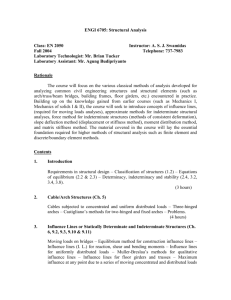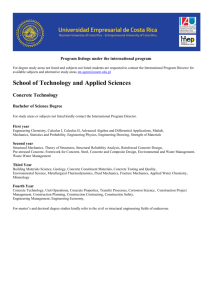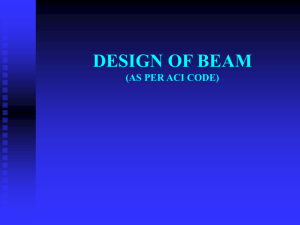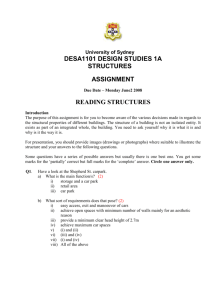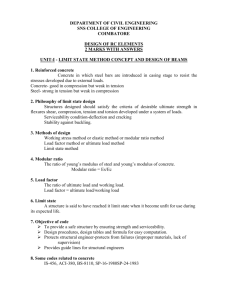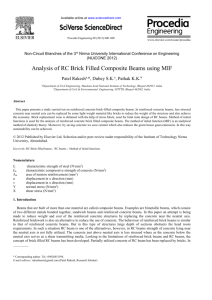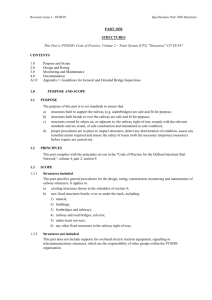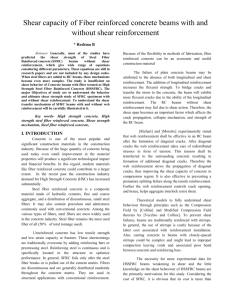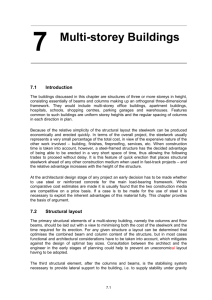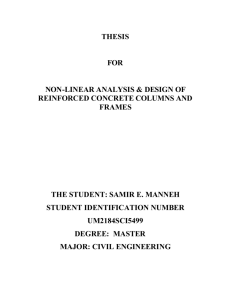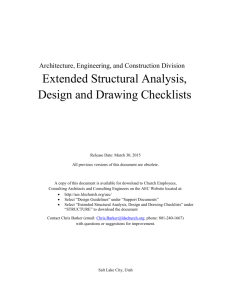Structural Analysis and Structural Design
advertisement
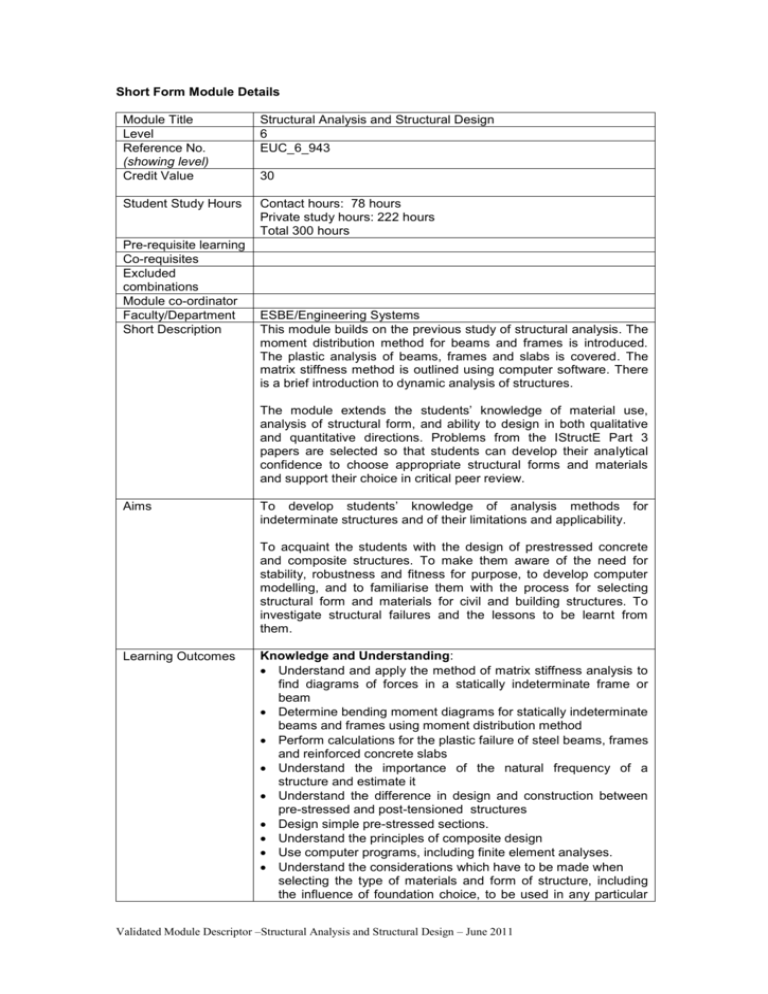
Short Form Module Details Module Title Level Reference No. (showing level) Credit Value Structural Analysis and Structural Design 6 EUC_6_943 Student Study Hours Contact hours: 78 hours Private study hours: 222 hours Total 300 hours Pre-requisite learning Co-requisites Excluded combinations Module co-ordinator Faculty/Department Short Description 30 ESBE/Engineering Systems This module builds on the previous study of structural analysis. The moment distribution method for beams and frames is introduced. The plastic analysis of beams, frames and slabs is covered. The matrix stiffness method is outlined using computer software. There is a brief introduction to dynamic analysis of structures. The module extends the students’ knowledge of material use, analysis of structural form, and ability to design in both qualitative and quantitative directions. Problems from the IStructE Part 3 papers are selected so that students can develop their analytical confidence to choose appropriate structural forms and materials and support their choice in critical peer review. Aims To develop students’ knowledge of analysis methods for indeterminate structures and of their limitations and applicability. To acquaint the students with the design of prestressed concrete and composite structures. To make them aware of the need for stability, robustness and fitness for purpose, to develop computer modelling, and to familiarise them with the process for selecting structural form and materials for civil and building structures. To investigate structural failures and the lessons to be learnt from them. Learning Outcomes Knowledge and Understanding: Understand and apply the method of matrix stiffness analysis to find diagrams of forces in a statically indeterminate frame or beam Determine bending moment diagrams for statically indeterminate beams and frames using moment distribution method Perform calculations for the plastic failure of steel beams, frames and reinforced concrete slabs Understand the importance of the natural frequency of a structure and estimate it Understand the difference in design and construction between pre-stressed and post-tensioned structures Design simple pre-stressed sections. Understand the principles of composite design Use computer programs, including finite element analyses. Understand the considerations which have to be made when selecting the type of materials and form of structure, including the influence of foundation choice, to be used in any particular Validated Module Descriptor –Structural Analysis and Structural Design – June 2011 situation. Intellectual Skills: Choose an appropriate method of analysis for a structure Understand limitations of each method of analysis Use mathematical methods to analyse engineering problems Apply engineering knowledge and understanding in the solution of problems and the development of designs Present a scheme to an audience using freehand sketches and drawings. Stimulate an active interest in engineering as an intellectual art as well as a professional activity. Practical Skills: Use computer software for structural analysis and design Carry out safely a series of planned experiments Use laboratory and field work equipment to generate data Analyse experimental results and determine their validity and accuracy Prepare technical reports Transferable Skills: Manage tasks and solve problems, transfer techniques and solutions from one area to another, apply critical analysis and judgement Learn effectively for the purpose of continuing professional development and in a wider context throughout their career Work constructively as a member of a group. Employability Students become competent at analysis and design of complex structures, use software and relate theory and practice, all of which should improve their chances at finding employment. Teaching and learning pattern Lectures and tutorials supplemented by printed handouts, worked solutions to tutorials and past examination questions. The lectures are complemented by laboratory and computer sessions, as well as seminars and project work with peer critique sessions. Indicative content Matrix Stiffness Method of Analysis Development of the Method. Use of the Method. Plastic Analysis for Beams and Frames Principle of Virtual Work. Lower Bound and Upper Bound Theories. Combination of Mechanisms. Yield Line Theory Development of the Method. Yield line patterns. Work method. Dynamic Analysis of Structures Natural Frequency, Damping, Resonance. Single and Multiple Degree of Freedom Systems. Moment Distribution Method Determination of Bending Moment Diagrams and Reactions on Single Storey Frames by Using the Moment Distribution Method. Finite Element Method Introduction to Finite Element Analysis. Stiffness Matrix. Shape Function. Analysis of 1D and 2D structures. General Validated Module Descriptor –Structural Analysis and Structural Design – June 2011 Philosophy of Design. Stability. Loading. Bracing and Shear Walls. Robustness. Environmental Structural Form Structural Layouts for Buildings, Bridges, Grandstands, etc. Choice of Suitable Materials. Steelwork Design Concept of Steel Framed Structures. Struts and Ties. Plate Girders. Trusses. Plastic Analysis and Design of Steel Portal Frames and Connections. Reinforced Concrete Design Load Combinations & Patterns. Moment Redistribution. Design of Continuous Beam. Flanged Sections. Shear & Torsion Design. Walls. Foundations. Pre-stressed Concrete Principles of Pre-stressed Concrete Design. Pre- and PostTensioning. Composite Design Principles of Composite design. construction. Shear connection. Assessment Elements & weightings Propped and Un-propped The module is assessed by a combination of examination and coursework. 70% 15% 15% 3 hour end of module written examination. Coursework based the laboratory testing of a frame taken to plastic failure and the Matrix Stiffness method using a computer package Coursework exercises including elements of the following: design exercises with presentation and critique, a report on a structural failure with analysis. NOTE: All the design exercises will be taken from Past I Strut E Part 3 Exam Questions. Indicative Sources (Reading lists) Core Coates, R.C., Coutie, M.G. and Kong, F.K., Structural Analysis, Nelson, 1992. Megson, T.H.G., Structural and Stress Analysis, Elsevier Butterworth Heinemann, 2005. Owen, G., Steel Designers Manual, Steel Construction Institute, 2003. Seward D., Understanding Structures, Macmillan, 1998. Background Arya, C., Design of Structural Elements, Chapman and Hall, 2009. Bhatt, P., Marshal and Nelson’s Structures, Longman Scientific & Technical, 1990. Calladine, C.R., Plasticity for Engineers: Theory and Applications, Horwood, 2000. Ghali, A., Neville, A.M. and Brown, T.G., Structural Analysis: a Unified Classical and Matrix Approach, 5th Ed., Spon Press, 2003. Irvine, H.M., Structural Dynamics for the Practising Engineer, Unwin, 1986. Validated Module Descriptor –Structural Analysis and Structural Design – June 2011 Jennings, A., Structures from Theory to Practice, Spon Press, 2004. Kirby, P.A. and Nethercot, D.A., Design for Structural Stability, Collins, 1985. Kong, F.K. and Evans, R.H., Reinforced and Prestressed Concrete, Van Nostrand Reinhold, 1987. McKenzie, W.M.C., Examples in Structural Analysis, Taylor & Francis, 2007. McKenzie,W., Design of Structural Elements, Palgrave, 2004. Moy, S.S.J., Plastic Methods for Steel and Concrete Structures, Macmillan, 1996. Reynolds, C.E. and Steedman, J.C. , Reinforced Concrete Designer’s Handbook, Spon, 1998. The Structural Engineer, Magazine of the Institution of Structural Engineers. Schueller W., The Design of Building Strutures, Prentice Hall, 1995. Tomlinson, M. J., Foundation Design and Construction, Longman UK,1986. Thompson, F. and Haywood, G.G., Structural Analysis Using Virtual Work, Chapman and Hall, 1986. Whitlow, R. (1996). Materials and Structures - Longman UK Validated Module Descriptor –Structural Analysis and Structural Design – June 2011

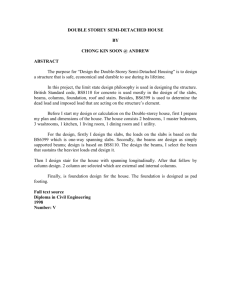
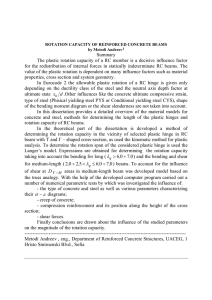

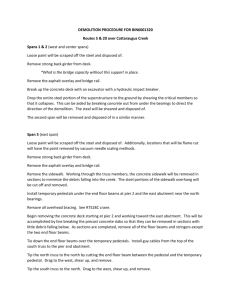
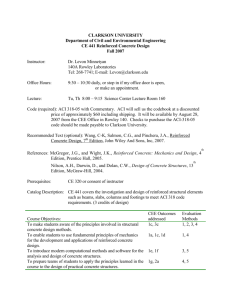
![Structural Applications [Opens in New Window]](http://s3.studylib.net/store/data/006687524_1-fbd3223409586820152883579cf5f0de-300x300.png)
